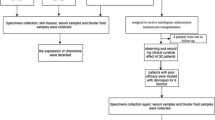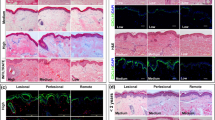Abstract
The larger number of T-lymphocytes in the periphery of vitiligo lesions and their association with angiogenesis are reported. The objective of this study was to investigate angiogenesis, VEGF and mast cell in vitiligo lesions. Specimens of 30 patients' biopsies, from lesional and perilesional nondepigmented skin were stained for mast cells, CD34 and VEGF. The evaluation was made by image analysis and the measured variables were statistically analyzed. A significantly increased number of CD34 and VEGF positive vessels and mast cells were detected in the centre of the lesion than in the periphery (p < 0.0001, p < 0.0001 and p = 0.001). There was a positive correlation of CD34, VEGF and mast cell number between the centre and the periphery of the lesions (r = 0.877, p < 0.0001; r = 0.946, p < 0.0001 and r = 0.863, p < 0.0001, respectively). The increased angiogenesis and mast cell numbers in the area where lymphocyte number is lower may be explained with the stepwise inflammatory process in vitiligo.






Similar content being viewed by others
References
Al Badri AMT, Todd PM, Garioch JJ, Gudgeon JE, Stewart DG, Goudie RB (1993) An immunohistological study of cutaneous lymphocytes in vitiligo. J Pathol 170(2):149–155
Aroni K, Tsagroni E, Kavantzas N, Patsouris E, Ioannidis E (2008) A study of the pathogenesis of rosacea: how angiogenesis and mast cells may participate in a complex multifactorial process. Arch Dermatol Res 300(3):125–131 Epub 2007 Dec 11
Artuc M, Hermes B, Steckelings UM, Grützkau A, Henz BM (1999) Mast cells and their mediators in cutaneous wound healing–active participants or innocent bystanders? Exp Dermatol 8(1):1–16
Bhushan M, McLaughlin B, Weiss JB, Griffiths CE (1999) Levels of endothelial cell stimulating angiogenesis factor and vascular endothelial growth factor are elevated in psoriasis. Br J Dermatol 141(6):1054–1060
Bradding P (1996) Human mast cell cytokines. Clin Exp Allergy 26(1):13–19
Brown LF, Berse B, Jackman RW, Tognazzi K, Manseau EJ, Dvorak HF, Senger DR (1993) Increased expression of vascular permeability factor (vascular endothelial growth factor), its receptors in kidney, bladder carcinomas. Am J Pathol 143(5):1255–1262
Cucchi ML, Frattini P, Santagostino G, Orecchia G (2000) Higher plasma catecholamine and metabolite levels in the early phase of nonsegmental vitiligo. Pigment Cell Res 13(1):28–32
Dell’Anna ML, Urbanelli S, Mastrofrancesco A, Camera E, Iacovelli P, Leone G, Manini P, D’Ischia M, Picardo M (2003) Alterations of mitochondria in peripheral blood mononuclear cells of vitiligo patients. Pigment Cell Res 16(5):553–559
Detmar M (1996) Molecular regulation of angiogenesis in the skin. J Invest Dermatol 106(2):207–208
Freedberg IM, Fitzpatrick TB, Goldsmith LA, Austen KF (eds) (1999) Disorders of melanocytes, sect 12, chap 89. In: Fitzpatrick’s dermatology in general medicine, vol 1, 5th edn. Mc Graw-Hill, New York, pp 949–960
Furness SG, McNagny K (2006) Beyond mere markers: functions for CD34 family of sialomucins in hematopoiesis. Immunol Res 34(1):13–32
Galli SJ (1993) New concepts about the mast cell. N Engl J Med 328(4):257–265
Gauthier Y, Cario Andre M, Taïeb A (2003) A critical appraisal of vitiligo etiologic theories. Is melanocyte loss a melanocytorrhagy? Pigment Cell Res 16(4):322–332
Gruber BL, Marchese MJ, Kew R (1995) Angiogenic factors stimulate mast-cell migration. Blood 86(7):2488–2493
Hasse S, Gibbons NC, Rokos H, Marles LK, Schallreuter KU (2004) Perturbed 6-tetrahydrobiopterin recycling via decreased dihydropteridine reductase in vitiligo: more evidence for H2O2 stress. J Invest Dermatol 122(2):307–313
Imokawa G, Yada Y, Kimura M, Morisaki N (1996) Granulocyte/macrophage colony-stimulating factor is an intrinsic keratinocyte-derived growth factor for human melanocytes in UVA-induced melanosis. Biochem J 313(Pt 2):625–631
Jiang WY, Chattedee AD, Raychaudhuri SP, Raychaudhuri SK, Farber EM (2001) Mast cell density and IL-8 expression in nonlesional and lesional psoriatic skin. Int J Dermatol 40(11):699–703
Knox CM, Rosacea SmolinG (1997) Int Ophthalmol Clin. Spring 37(2):29–40
Longley J, Duffy TP, Kohn S (1995) The mast cell and mast cell disease. J Am Acad Dermatol 32(4):545–561
Marks RM, Roche WR, Czerniecki M, Penny R (1986) Nelson DS. Mast cell granules cause proliferation of human microvascular endothelial cells. Lab Invest 55(3):289–294
Mor F, Quintana FJ, Cohen IR (2004) Angiogenesis-inflammation cross-talk: vascular endothelial growth factor is secreted by activated T cells and induces Th1 polarization. J Immunol 172(7):4618–4623
Moretti S, Spallanzani A, Amato L, Hautmann G, Gallerani I, Fabbri P (2002) Vitiligo and epidermal microenvironment: possible involvement of keratinocyte-derived cytokines. Arch Dermatol 138(2):273–274
Moretti S, Spallanzani A, Amato L, Hautmann G, Gallerani I, Fabiani M, Fabbri P (2002) New insights into the pathogenesis of vitiligo: imbalance of epidermal cytokines at sites of lesions. Pigment Cell Res 15(2):87–92
Ortonne JP (2003) Pigmentary disorders. Vitiligo and other disorders of hypopigmentation. In: Bologna JL, Jorizzo JL, Rapini RP (eds) Dermotology, 2nd edn. Mosby, New York, pp 947–974
Oyarbide-Valencia Κ, van den Boorn JG, Denman CJ, Li M, Carlson JM, Hernandez C, Nishimura MI, Das PK, Luiten RM, Le Poole IC (2006) Therapeutic implications of autoimmune vitiligo T cells. Autoimmun Rev 5(7):486–492
Probert L, Plows D, Kontogeorgos G, Kollias G (1995) The type I interleukin-1 receptor acts in series with tumor necrosis factor (TNF) to induce arthritis in TNF-transgenic mice. Eur J Immunol 25(6):1794–1797
Rothe MJ, Nowak M, Kerdel FA (1990) The mast cell in health and disease. J Am Acad Dermatol 23(4 Pt 1):615–624
Schallreuter KU, Chiuchiarelli G, Cemeli E, Elwary SM, Gillbro JM, Spencer JD, Rokos H, Panske A, Chavan B, Wood JM, Anderson D (2006) Estrogens can contribute to hydrogen peroxide generation, quinone-mediated DNA damage in peripheral blood lymphocytes from patients with vitiligo. J Invest Dermatol 126(5):1036–1042
Solano F, Briganti S, Picardo M, Ghanem G (2006) Hypopigmenting agents: an updated review on biological, chemical and clinical aspects. Pigment Cell Res 19(6):550–571
Steitz J, Wenzel J, Gaffal E, Tüting T (2004) Initiation regulation of CD8+ T cells recognizing melanocytic antigens in the epidermis: implications for the pathophysiology of vitiligo. Eur J Cell Biol 83(11–12):797–803
Sugita K, Izu K, Tokura Y (2006) Vitiligo with inflammatory raised borders, associated with atopic dermatitis. Clin Exp Dermatol Jan 31(1):80–82
Tharp MD (1991) The mast cell and its mediators. In: Goldsmith LA (ed) Physiology, biochemistry and molecular biology of the skin. Oxford University Press, New York, pp 1099–1120
van den Wijngaard R, Wankowicz-Kalinska A, Le Poole C, Tigges B, Westerhof W, Das P (2000) Local immune response in skin of generalized vitiligo patients. Destruction of melanocytes is associated with the prominent presence of CLA+ T cells at the perilesional site. Lab Invest 80(8):1299–1309
Weber S, Krüger-Krasagakes S, Grabbe J, Zuberbier T, Czarnetzki BM (1995) Mast cells. Int J Dermatol 34(1):1–10
Conflict of interest statement
None.
Author information
Authors and Affiliations
Corresponding author
Rights and permissions
About this article
Cite this article
Aroni, K., Voudouris, S., Ioannidis, E. et al. Increased angiogenesis and mast cells in the centre compared to the periphery of vitiligo lesions. Arch Dermatol Res 302, 601–607 (2010). https://doi.org/10.1007/s00403-010-1040-9
Received:
Revised:
Accepted:
Published:
Issue Date:
DOI: https://doi.org/10.1007/s00403-010-1040-9




